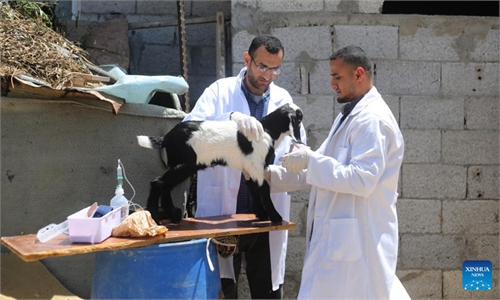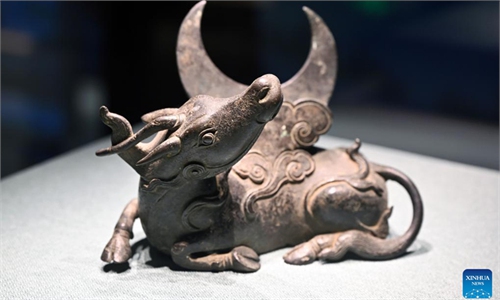ARTS / CULTURE & LEISURE
Beijing ancient sites take steps to protect migrating birds
Swift action

Swifts fly over the Summer Palace in Beijing on June 18, 2019.Photo: VCG
First spotted in Beijing, Apus apus Pekinensis is a subspecies of the common swift (Apus apus). Along with other subspecies, these swifts come to China's capital city as a migration destination every year from April to August. Upon arrival, they cram in the corners of buildings to raise the next generation before launching an international migration south.To avoid disrupting them, during peak breeding season the staff at the Front Gate, located south of the Tiananmen Square along Beijing's Central Axis, have decided to postpone their renovation plans for an ancient wooden building.
"Those birds love to nest in small, concrete areas away from the ground such as in the cracks of the ancient wooden buildings scattered around the city, so protecting these ancient structures is one of the ways to also protect the birds," Zhao Xinru, an associate professor of zoology at Beijing Normal University, told the Global Times. Zhao is one of the earliest scholars to promote bird watching in China.
In China, swifts enjoy a good reputation. They were the prototype for the Olympic mascot "Nini" from the Beijing Summer Olympic Games in 2008; one of their subspecies is named after Beijing; and more importantly, their migrating route follows along the regions taking part in China's Belt and Road Initiative.
However, from 2001 to 2014, the population of these birds has remained at around a relatively low 3,000. To protect this city-friendly species, Beijing has implemented policies over the past few years to protect its food chain and habitat.
Eco in action
In 2017, staff at the Front Gate launched a series of projects such as making artificial straw nests in the buildings and installing cameras for daily observation of the animals.
"When the wood becomes cracked, swifts use the space to make nests. So when carrying out repairs we leave the cracks so that the birds can keep their living spaces," staff member Guan Zanxiu noted in an interview.
Additionally, other ancient building sites such as the Summer Palace, Lama Temple and Temple of Heaven are also ideal habitats for these birds.
"The Kuoru Pavilion at the Summer Place built during the reign of the Qianlong Emperor (1736-1796) in the Qing Dynasty (1644-1911) is also one of the main areas where swifts in Beijing live and breed," Liu Yang, an expert from the Old Summer Palace association told the Global Times on Wednesday.
"The number of swifts at the Kuoru Pavilion sometimes reaches 600 to 700," he said.
In March 2021, peak breeding season, the Kuogru Pavilion was closed for the first time ever in order to protect the swifts' habitat at the Summer Palace.
"We will not start repairs on the ancient buildings until the end of their migration season," Lü Zhou, vice president of the Chinese Commission for the International Council, also noted to the Global Times.
Experts also told the Global Times some other good news: A highly adaptable species, swifts also build nests in modern buildings.
"As the city has evolved over the past many years, we can still see nests in the old dormitory buildings on university campuses in Beijing, as well as the gaps between the buildings and near the drainage pipes of overpasses," added Zhao.
For Zhao, the common swift numbers are "the most direct response to Beijing's rich biodiversity" as they feed on insects such as aphids, mosquitoes and flies.
Therefore, besides buildings, water resource protection is also of particular importance in reviving swifts in the city. The restoration and construction of over 11,000 hectares of wetlands in Beijing is a major highlight of the 13th Five-Year Plan period (2016-20).
International cooperation
"Joint protection with other countries of the habitats along the birds' migration route is also very crucial," Zhou Jinfeng, secretary-general of the China Biodiversity Conservation and Green Development Foundation, told the Global Times on Thursday.
In July and August, the swifts will depart on their journey to Africa.
"After leaving Beijing, they will soon head all the way west, pass through Northwest China's Dunhuang and head on to Mongolia, Russia, and all the way to Central Asia passing Kazakhstan and 20 other countries. Finally, they will head south, resting on the African continent. This partially coincides with China's Belt and Road Initiative route.
"The protection of swifts could contribute to the joint ecological and environmental protection cooperation within the framework of the B&R Initiative, which is an excellent opportunity for our country to promote ecological civilization and a community with a shared future for mankind," Zhang said.
He noted that besides swifts, China and many other countries who are the members of the B&R Initiative have co-launched cooperative projects for the protection of many wild animals, including the protection of endangered bird species such as the great buzzard in cooperation with Russia and Mongolia, the pangolin with Nigeria, and eagles with Pakistan.
"What we want to protect is not just one rare species, but the entire ecological environment. We aim to build an environmentally friendly Belt and Road," Zhang emphasized.




